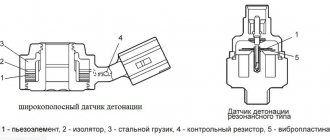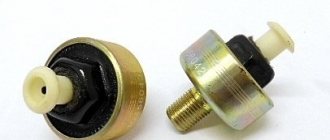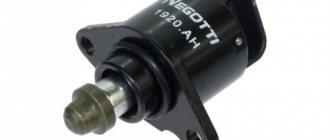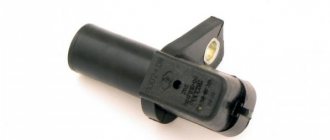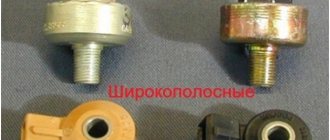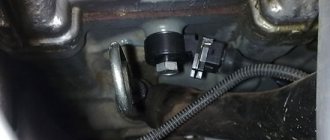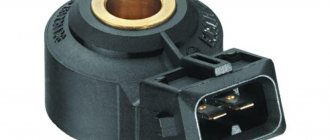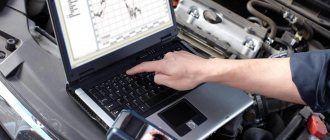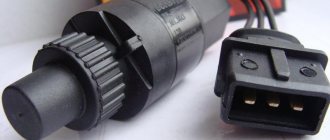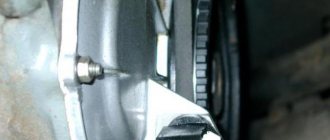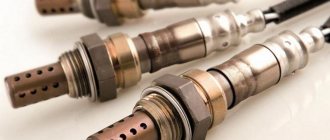Despite the fact that the car has a considerable number of installed sensors responsible for various parameters of its operation, only a few of them are of the greatest importance. These include the knock sensor of the VAZ 2114.
This device is used to record vibration (detonation) conditions of fuel during its direct combustion inside the engine. In addition, there is a constant transmission of data in the form of signals to the vehicle's ECU. As a result, the electronic unit adjusts (changes) the ignition timing. The importance of the device is due to the fact that if it fails or malfunctions, the ECU does not receive reliable data from it, and as a result, the detonation process is not damped.
The above circumstances have a destructive effect on the car engine. Therefore, negligence or failure to replace a part in a timely manner can destroy any motor. And this is not an exaggeration.
From this article you will learn why a knock sensor is needed, what problems may occur during its operation, and how to check and replace the sensor yourself.
Where is the knock sensor of the VAZ 2114
It is located between the second and third cylinders on the engine block (if viewed from the radiator side). Its location from the point of view of providing simple, unobstructed access is conveniently implemented in eight valve engines. But in more complex engines (16 valves), some inconvenience appears. This is due to the high density and accumulation of units in the engine compartment.
Why is detonation dangerous for an engine?
To effectively convert the reciprocating motion of the piston into rotational motion of the crankshaft, the maximum pressure in the combustion chamber during the power stroke must be reached approximately 15-20° after top dead center (TDC). In this case, the fuel-air mixture is ignited by an arc discharge of the ignition spark, and the speed of propagation of the flame front does not exceed 30-40 m/s.
In the event of excessive heating of the air at the end of the compression stroke, particles with an excessively high temperature appear in the combustion chamber, the fuel mixture self-ignites. The speed of propagation of the flame front reaches 2000 m/s. This explosive nature of detonation leads to increased load on the parts of the crank mechanism (CPM) and cylinder-piston group (CPG). Consequences of detonation:
- burnout of valves and piston;
- destruction of piston partitions;
- burnout of the cylinder head gasket;
- local overheating of the pistons, cylinder walls and the associated loss of elasticity of the piston rings;
- accelerated wear of CPG parts. Explosive combustion destroys the oil film, causing dry friction;
- melting of the spark plug electrode.
Most common faults
In fact, cases of failure of the detonation detection device itself are not so common. In most cases, the reasons for incorrect operation are auxiliary factors, such as:
- Damage to the wires connecting the control unit to the sensor. As a result, the unit does not read signals from the device; contamination of the metal part of the part;
- corrosion (as a result of environmental influences);
- chafing breaks and wires;
- oxidation of one or both contacts.
Less commonly, there is a complete failure of the internal piezo element (plate) of the device. In most cases, the sensor cannot be repaired, and the repair itself is not entirely rational in terms of effort, time and money. The surest way is to buy a new product; fortunately, it is not expensive.
List of errors associated with DD from the on-board computer
The cause of the failure can be found out by analyzing the error signal on the console:
- 0325 indicates a break in the DD circuit, which can be eliminated by cleaning the sensor connectors from oxidation and ringing the wiring;
- 0325 may also indicate that the timing belt is shifted by one tooth; it is necessary to check that the belt is installed correctly;
- 0326, 0327 indicates a low controller signal, requires checking the connectors, securing the nut with a force of 10-23 Nm, the action is performed with a special torque wrench.
- 0328 - the control signal is higher than normal, may appear when the electrical circuit is broken, a piercing element, or a faulty DD.
Signs of malfunction of the knock sensor VAZ 2114
The knock sensor of the VAZ 2114 is a device on the serviceability of which the overall performance of the engine of the fourteenth depends. If the sensor fails, you will notice the following changes in the operation of the car:
- twitching of the internal combustion engine of the car;
- reduction in power indicators;
- an error appears on the instrument panel;
- increasing engine operating temperatures and rapid heating;
- increased fuel consumption;
- persistent smell of gasoline.
In order to understand the reason for the incorrect operation of the internal combustion engine, it is necessary to connect a diagnostic tool. Such a device allows you to read and display the code of a particular error. In our case, the following codes are distinguished: from 0325 to 0327 inclusive. All of them indicate that the sensor is not working properly.
How to understand that it is out of order
The product is installed in cars with an electronic control circuit. Diagnosing faults in such machines is simple - if everything works correctly, the sensors on the dashboard remain inactive. The main sign of a malfunctioning knock sensor is the appearance of the inscription “Check engine” (CHECK). It can burn constantly, or it can appear and disappear.
If the sensor breaks down, acceleration performance deteriorates. The car starts, but works worse - it accelerates poorly, vibration occurs at rpm below 1000, power drops and fuel consumption increases, and the amount of smoke from the exhaust increases.
Why is this happening? Sensor malfunctions are related to automotive electronics. The following reasons are possible:
- the signal wire is broken;
- a short to ground has occurred;
- there was a short circuit in the on-board network of any wire of the device;
- the shielding braid is damaged;
- the power unit control unit has failed;
- something is damaged inside the sensor itself.
How much does a knock sensor cost for a VAZ 2114?
On VAZ 2114 cars of early production years there is a Lada sensor 21120385501001. It has an extremely low prevalence and because of this its price is high and amounts to 800-1300 rubles. The only commonly found analogue is General Motors 21120-3855010-01 with a cost of 1600-1800 rubles.
The original broadband DD has article number 21123855020. Its price is much lower and amounts to 100-160 rubles. Its good analogues are presented in the table.
Table - Good analogues of the original VAZ 2114 knock sensor
| Manufacturer | vendor code | Approximate cost, ruble |
| Fenox | SD10100O7 | 210-420 |
| Decaro | 2112-3855020 | 360-490 |
| Samara 2112 | 3855020 | 200-250 |
| Road map | 21123855020 | 260-380 |
| ERA | 550489 | 300-340 |
Detonation - what is it?
This is the name given to the process of random combustion of the fuel mixture without a spark. If we assume that the pressure in the cylinders exceeds the permitted octane number, the fuel will ignite on its own. The lower the number, the process is possible with little compression.
At the moment of engine detonation, self-ignition occurs uncontrollably; there is no general combustion center.
If you depict the dependence of cylinder pressure on the angle of the ignition system, then everything is presented in the form of graphs. They show that at the moment of detonation the maximum pressure values are twice as high as at the moment of normal combustion. These types of loads can cause motor failure, up to the appearance of cracks in its block. There are several main reasons that influence the detonation effect:
- incorrect octane number of fuel poured into the tank;
- engine design features;
- nuances of vehicle operation.
How to check the knock sensor of a VAZ 2114
Before replacing the knock sensor with a new product, there are several recommendations for checking its performance, as well as identifying the reasons for the incorrect operation of the device. If on 8 valve engines access to the product is quite free, then on sixteen valve engines you will have a little more difficulty. To check the functionality of the sensor itself, you can resort to two available methods:
- checking with a multimeter;
- Testing operation without removal.
How to check the knock sensor of a VAZ 2114 with a multimeter
To check the knock sensor of a VAZ 2114 with a multimeter, follow these steps:
- We dismantle the sensor (how to do this is written in the next section of the article);
- We connect the multimeter probes to the DD contacts (if it is two-contact), if it is single-contact, the first probe to the wire, the second to the device body;
- We switch the tester to voltmeter mode and set the upper measurement limit to 200 mV;
- Tap a screwdriver (or any metal object) on the sensor body;
- If the device is working properly, the multimeter will show voltage surges, the magnitude of which should be directly proportional to the force of the impact (this indicates that the device retains the ability to convert mechanical energy into alternating current). If the multimeter readings do not change, the DD does not work.
If you find out that the device itself is working properly, but DD errors are displayed on the on-board computer or the car is not working as it should, the problem is most likely in the oxidized contacts of the sensor. Treat them with WD-40 or a similar solvent, install the DD in place and check the result. If that doesn't help, replace the knock sensor.
How to check the VAZ 2114 knock sensor without removing it
The second method, without removing the knock sensor on the VAZ 2114, is as follows. First, you must start the car engine and maintain its speed in the range from one and a half thousand to two thousand.
At the same time, you need to find the sensor and freely reach it. After that, take a convenient metal tool or device, knock on the part several times with increasing force (the main thing is not to overdo it). If the device is in good working order, the engine speed should increase when tapping (remember the principle of both operation and adjustment by the ECU). If after tapping no reaction occurs, you should dismantle the sensor and check it thoroughly with the same multimeter.
In any case, it is recommended to carry out a visual inspection of the product itself and pay attention to the following features:
- tightness of sensor mounting and connection;
- the degree of corrosion and contamination on the device body;
- contact connection (over time it may oxidize and partially or completely lose conductivity).
Repair or replacement?
You decide. The cost of the product depends on the car model and the manufacturer of the component - for a replacement you will need to pay an amount approximately equal to its price. You can change the device yourself; for this you will need a room with a pit. Self-repair is also possible: if you are well versed in cars, it will take no more than an hour.
Checking the knock sensor is an easy task that doesn't require expensive tools. Of course, a computer check at a service station will be more accurate, but if you don’t want to spend money, you can do it yourself.
- Author: Dmitry Buimistrov
Hello! My name is Dmitry, I am a journalist by training. I specialize in automotive topics - I started my career in an online store of automotive components, and I myself am a car enthusiast. Rate this article:
- 5
- 4
- 3
- 2
- 1
(22 votes, average: 3.9 out of 5)
Share with your friends!
Replacing the knock sensor on a VAZ 2114 - step-by-step instructions
Replacing the DD is an extremely simple process. You can change the knock sensor of a VAZ 2114 within 5 minutes; for this you only need a 20 or 13 socket wrench (depending on what specific type of sensor is installed on your fourteenth).
So, after receiving a large block of theoretical information, we will proceed to practical exercises and thoroughly analyze the entire process of replacing (removing) the sensor.
Instructions for 8 valve engine
To perform the work you will need a 13mm wrench or socket.
- We gain free access and unscrew the fastening nut.
- Then disconnect the contact wires from the device connector.
- We extract the part.
Reinstallation is carried out in the opposite sequence. Everything is quite simple.
Instructions for engine 16 valves VAZ 2114
We use the same tools as in the first case. The only addition is the need to remove the internal combustion engine protection and ensure a convenient position and access under the bottom of the car. To do this, you can place the car on an overpass or repair pit. The removal and installation process is similar to the first example.
Causes of fuel detonation
- Mismatch between the octane number of gasoline and the compression ratio in the engine.
- Low heat number of spark plugs. Self-ignition of fuel assemblies occurs from contact with a hot electrode.
- Early ignition timing.
- Deposits in the combustion chamber. With a large accumulation of carbon deposits on the pistons and valves, the area of the combustion chamber decreases, which naturally leads to an increase in the compression ratio. Detonation can also occur due to contact of fuel assemblies with overheated particles of oil deposits.
- Mixture too lean. Excess air accelerates the oxidation reaction of the fuel with oxygen and increases the risk of spontaneous combustion of the mixture.
Useful tips
Recently, cases of selling defective spare parts and sensors without the necessary internal contents have become more frequent. Therefore, immediately after purchasing the product you need, it is recommended to check its performance with a multimeter. You should know that on older VAZ 2114 models the knock sensor (resonant) differs from modern products (broadband) in price, design features and operating principles. Therefore, you should buy a product that is designed specifically for your car model. A device with a resonant type of operation cannot be replaced by modern products without modifying the ECU.
Types of sensors
According to the spectral characteristics, historically there are two of them - resonant and broadband .
In the first, a pronounced reaction to very specific sound frequencies is used to increase sensitivity. It is known in advance what spectrum is produced by the parts suffering from the shock wave; it is for them that the sensor is structurally adjusted.
Related article: Replacing the front strut support bearing with and without removing the shock absorber
A broadband type sensor has less sensitivity, but it detects vibrations of different frequencies. This allows you to unify the devices and not have to select their characteristics for a specific engine, and the greater ability to pick up weak signals is not in great demand; detonation has sufficient acoustic volume.
A comparison of both types of sensors led to the complete displacement of resonant DDs. Currently, only two-contact broadband toroidal sensors are used, secured to the block with a central pin and nut.
